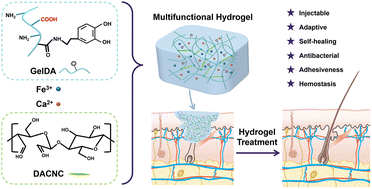Biomass-derived ultrafast cross-linked hydrogels with double dynamic bonds for hemostasis and wound healing†
Abstract
Developing novel hemostatic materials with accelerating wound healing functions has raised widespread attention recently. To adapt to irregular and incompressible wounds, we fabricated a series of biomass-derived ultrafast cross-linked adhesive hydrogels with adjustable gelation time and injectable properties through Schiff-base and ionic coordinate bonds among catechol-conjugated gelatin (GelDA), dialdehyde cellulose nanocrystals (DACNCs), calcium ions (Ca2+) and ferric iron (Fe3+). The fast-gelling hydrogels possess adjustable gelation time and mechanical properties by altering the contents of DACNCs and Fe3+. With double-dynamic-bond crosslinking, the hydrogels are endowed with the desired self-healing and injectable performance compared to gelatin-based hydrogels without DACNCs. Additionally, the hydrogels present enhanced adhesiveness, NIR responsiveness and antibacterial activity with the introduction of catechol groups and the formation of catechol–Fe complexes. Both in vitro and in vivo hemostatic assays and degradation experiments confirm that the hydrogels achieve rapid hemostasis and display fantastic biodegradability. As demonstrated by a rat full-thickness skin defect model, the hydrogels with multifunctionality remarkably accelerate the regeneration of wound tissues. Thus, the ultrafast cross-linked hydrogels are potentially valuable as hemostatic materials for wound healing applications in the biomedical field.



 Please wait while we load your content...
Please wait while we load your content...